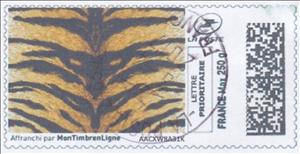Stamp: Tiger's Back (Personalized and Private Mail Stamps 2020)
Tiger's Back (Personalized and Private Mail Stamps 2020)
01 January (Personalized and Private Mail Stamps ) within release France : TimbrEnLigne. Nature and Landscapes goes into circulation Stamp Tiger's Back face value 250 Gram
| Stamp Tiger's Back in catalogues | |
|---|---|
| Colnect codes: | Col: FR-TIM 2020-221 |
Stamp is square format.
Also in the issue France : TimbrEnLigne. Nature and Landscapes:
- Stamp - Fish in Black face value Lettre;
- Stamp - The Forest. La Foret face value 20;
- Stamp - Horses face value 20;
- Stamp - Blue Diamond face value 20;
- Stamp - Tiger's Back face value 250;
- Stamp - Green Leaf 3 face value 100;
- Stamp - Blue Clover Leaf face value 20;
- Stamp - Kitten Reflection face value 20;
- Stamp - Sunset over Water 2 face value 20;
- Stamp - Inspiration face value 20;
- Stamp - Floral face value 20;
- Stamp - Cat's Eye face value 20;
- Stamp - Blue Fish face value 50;
- Stamp - Lily of the Valley 2 face value 20;
- Stamp - Lamb face value Lettre;
- Stamp - Grand Canyon face value 20;
- Stamp - Fish on Orange background face value 20;
- Stamp - Male Lion face value 20;
- Stamp - Cloud over Volcano View 1 face value 20;
- Stamp - Cloud over Volcano View 2 face value 20;
- Stamp - Lake and Mountain View 12 face value 20;
- Stamp - Rain Forest face value 20;
- Stamp - Rainbow coloured cloudscape face value 20;
- Stamp - Volcanic Lake. Rotorua New Zealand face value 20;
|
Data entry completed
46%
|
|
|---|---|
| Stamp Tiger's Back in digits | |
| Country: | Personalized and Private Mail Stamps |
| Date: | 2020-01-01 |
| Emission: | Personalized - Official |
| Format: | Stamp |
| Face Value: | 250 Gram |
Stamp Tiger's Back it reflects the thematic directions:
Animals are multicellular, eukaryotic organisms of the kingdom Animalia (also called Metazoa). All animals are motile, meaning they can move spontaneously and independently, at some point in their lives. Their body plan eventually becomes fixed as they develop, although some undergo a process of metamorphosis later on in their lives. All animals are heterotrophs: they must ingest other organisms or their products for sustenance.
Mammals are any vertebrates within the class Mammalia (/məˈmeɪli.ə/ from Latin mamma "breast"), a clade of endothermic amniotes distinguished from reptiles (including birds) by the possession of a neocortex (a region of the brain), hair, three middle ear bones and mammary glands. All female mammals nurse their young with milk, secreted from the mammary glands. Mammals include the largest animals on the planet, the great whales. The basic body type is a terrestrial quadruped, but some mammals are adapted for life at sea, in the air, in trees, underground or on two legs. The largest group of mammals, the placentals, have a placenta, which enables the feeding of the fetus during gestation. Mammals range in size from the 30–40 mm (1.2–1.6 in) bumblebee bat to the 30-meter (98 ft) blue whale. With the exception of the five species of monotreme (egg-laying mammals), all modern mammals give birth to live young. Most mammals, including the six most species-rich orders, belong to the placental group. The largest orders are the rodents, bats and Soricomorpha (shrews and allies). The next three biggest orders, depending on the biological classification scheme used, are the Primates (apes and monkeys), the Cetartiodactyla (whales and even-toed ungulates), and the Carnivora (cats, dogs, seals, and allies).
The tiger (Panthera tigris) is a member of the genus Panthera and the largest living cat species native to Asia. It has a powerful, muscular body with a large head and paws, a long tail and orange fur with black, mostly vertical stripes. It is traditionally classified into nine recent subspecies, though some recognise only two subspecies, mainland Asian tigers and the island tigers of the Sunda Islands.



